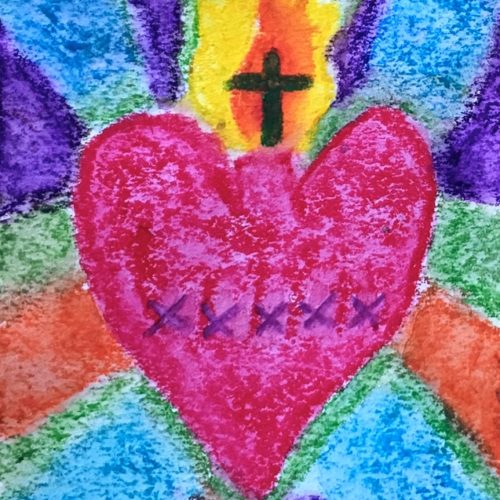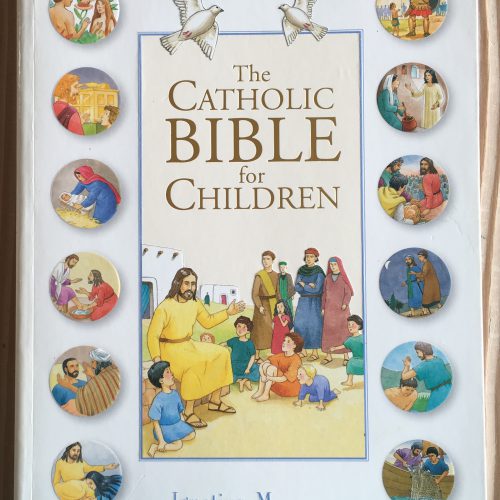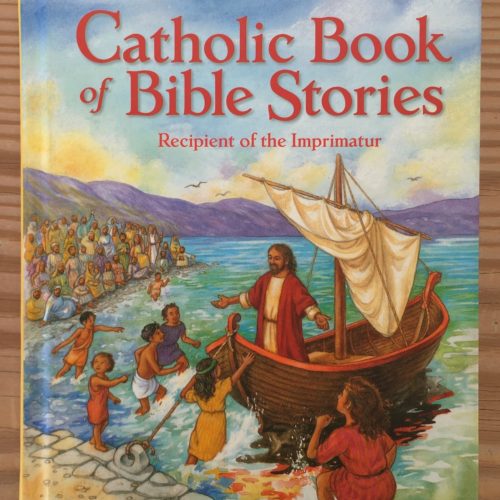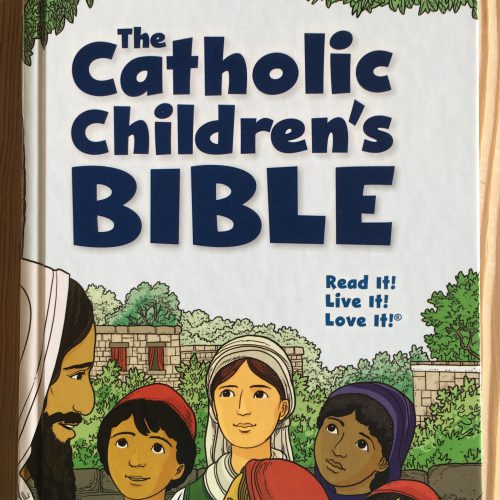“The First Pope”
One day Jesus said to Peter, “You are Peter, and upon this rock I will build my church.” Source: Lessons from Pope Francis for Children page 4
“After Jesus rose from the dead, Peter was filled with the Holy Spirit and began sharing the good news of Jesus’ life, death, and resurrection with everyone he met. Just as Jesus said, Peter became the leader of the church.” Source: Lessons from Pope Francis for Children page 4
For Families to Share Together:
Pray the Rosary with your children. Use the Rosary crucifix to cross yourselves:
How to Pray the Rosary Source: Catholic Child’s Prayer Book By Rev. Thomas J. Donaghy St. Joseph Junior Books, Page 15
“We begin the Rosary with the sign of the Cross (for this is the way that we begin all of our prayers.)
After this, we pray the Apostles’ Creed. This is a very ancient prayer that proclaims the important truths of our faith.
After the Apostle’s Creed, we pray one Our Father, three Hail Marys and one Glory Be.
Now we come to the most important reason we pray the Rosary: to meditate on the Mysteries of our Faith. We proclaim each of the five Mysteries, followed by one Our Father, ten Hail Marys, and one Glory Be.
Remember, the reason for praying the Rosary is not to tally how many prayers we can say. It is to meditate on God’s love as shown in the lives of Jesus and Mary. This is why we hold the Rosary while we pray, so that we can keep track of the number of prayers we have said.”
Begin learning the five Luminous Mysteries, “Mysteries of Light: THE BAPTISM OF THE LORD, THE WEDDING OF CANA, THE PROCLAMATION OF THE KINGDOM, THE TRANSFIGURATION, and THE INSTITUTION OF THE EUCHARIST.”
The Apostles’ Creed from Catholic Online
Happening This Week
October 22, 2017, Saint John Paul II Source: FranciscanMedia.org
“Elected pope in October 1978, he took the name of his short-lived, immediate predecessor. Pope John Paul II was the first non-Italian pope in 455 years. In time, he made pastoral visits to 124 countries, including several with small Christian populations.
John Paul II promoted ecumenical and interfaith initiatives, especially the 1986 Day of Prayer for World Peace in Assisi. He visited Rome’s main synagogue and the Western Wall in Jerusalem; he also established diplomatic relations between the Holy See and Israel. He improved Catholic-Muslim relations, and in 2001 visited a mosque in Damascus, Syria.”
October 18, 2017, Saint Luke the Apostle Source: FranciscanMedia.org
Saint Luke was the only Apostle who was a gentile. Gentile means, “non-Jew.” Luke was “a Syrian from Antioch.” He is the writer of The Gospel of Luke, and he traveled with Paul to Jerusalem and then to Rome.
“Luke wrote as a Gentile for Gentile Christians. His Gospel and Acts of the Apostles reveal his expertise in classic Greek style as well as his knowledge of Jewish sources. There is a warmth to Luke’s writing that sets it apart from that of the other synoptic Gospels, and yet it beautifully complements those works. The treasure of the Scriptures is a true gift of the Holy Spirit to the Church.”
October 17, 2017, Saint Margaret Mary Alacoque (July 22, 1647 – October 17, 1690) Source: FranciscanMedia.org
“Margaret Mary was chosen by Christ to arouse the Church to a realization of the love of God symbolized by the heart of Jesus.”

We Learn Through Storytelling
This past June, I traveled to Israel to see many of the Holy Sites of Christianity. My son and I traveled to a beautiful area in the Golan Heights in Israel, called Banias. It is believed to be here that Jesus, told Peter, “Upon this rock, I shall build my church.” The ancient people who lived and worshipped here centuries before Christ, built a temple to the pagan god, Pan. The brutal king, Herod, also built a temple here to honor the Roman king, Augustus.
Earlier in my trip in June, a friend of my son, Father William, gave our family a wonderful tour of an ancient church in Rome. I learned that earliest people remembered the sites where great things, or bad things, had occurred. Often, a temple, and then later a church, would eventually be built on the site. If the memory was a bad one, the people would obliterate the temple or palace and start over again. The church we toured had several layers of churches, one on top of the other. We descended to the street level of ancient Rome, visible under this church, through many years of excavations and archeological exploration.
When I learned that it was likely that Jesus had been at Banias when he told Peter that he was going to be the builder of the Church, I thought of what I had learned in the private church tour. I thought of the powerful significance of Christ, “conquering paganism,” and “obliterating” the memory of Herod and the Roman King, Caesar Augustus, by “symbolically building” on top of this site. I don’t know if scholars see it this way, but for me the mental image was powerful.
Parents, please help your children understand the meanings of the highlighted words.
Photos of Banias
We Learn Through Reading
“Jesus gathered all of his disciples around him. He named twelve apostles to preach the gospel and gave them the power to cast out demons and heal the sick. These twelve were: Peter, his brother Andrew, James, his brother John, Philip, Matthew, Bartholomew, Thomas, James, Thaddeus, Simon, and Judas Iscariot.” My First Communion Bible By Sarah Laurell and Fr. Benedict Groeschek, C.F.R., Page 22
The following books have lovely stories about Jesus “calling his disciples.” The books are arranged starting with books for the youngest children and ending with books for older children.
The Catholic Bible for Children
Catholic Book of Bible Stories
The Children’s Illustrated Bible
The Catholic Children’s Bible (I think this is excellent for children 12 and older.)
The Didache Bible Read Matthew, chapter 4:18-22 “Jesus Calls the First Disciples”

We Learn Through Writing
Reinforce the statement from Jesus to Peter, “…upon this rock I will build my Church.” by using clean flat river rocks as a canvas for Sharpies, stickers, and tempera paint. This child chose to write the phrase, “God is love.” Children enjoy, and learn from, this fun craft.

Click to read how to paint rocks with kids.
We Celebrate Through Song and Prayer
This charming poem or prayer is very old and I couldn’t find written music to accompany it.
Children can easily learn this as a special prayer for the Holy Family, and to reflect on the “Sacred Heart” and “Immaculate Heart.”
“For Catholic Children: Page 103”
“Heart of Jesus, I adore Thee,
Heart of Mary, I implore Thee,
Heart of Joseph, pure and just–
In these hearts, I put my trust.”
Source: Hymnary.org
We Celebrate Through Art
As we continue learning about the Holy Family — Jesus, Mary and Joseph– invite your child or children to paint the “Sacred Heart of Jesus” and/or “The Immaculate Heart of Mary.” The samples were done with watercolor crayons on a small piece of watercolor paper, cut from a large pad. A child or children can draw a heart with the watercolor crayons, fill in the background by rubbing a crayon that has had the paper peeled off, lengthwise, then use a finger dipped in water to turn all the crayon artwork into a painting. The symbols that are important to include for the Sacred Heart of Jesus are: the crown of thorns, drawn here as a row of XXXs; the red heart; flames coming from the heart; colorful rays of light from the heart; and the cross. Saint Margaret Mary Alacoque is responsible for creating the “Sacred Heart of Jesus” for devotion. The symbols for The Immaculate Heart of Mary are: the lily at the top of the heart, the cross, and a garland of roses on the heart.



















